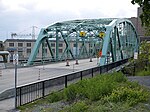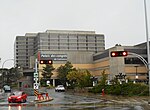Terrasses de la Chaudière

Les Terrasses de la Chaudière is a complex of government office buildings in Gatineau, Quebec, Canada. The complex was built in 1978 as part of Prime Minister Pierre Trudeau's initiative to see more federal workers based in the Quebec side of the Ottawa River. It was built by developer Robert Campeau and then leased to the government. This arrangement caused some controversy as Campeau had close links to the governing Liberals. The complex was named after the nearby Chaudière Falls in the Ottawa River. Today its three towers hold some 6,500 federal government office workers. The complex houses the headquarters of Crown-Indigenous Relations and Northern Affairs Canada (North Building), the headquarters of the Department of Canadian Heritage (Jules Léger Building (South)), the headquarters of the Canadian Transportation Agency (Jules Léger Building (South)), the headquarters of the Canadian Radio-television and Telecommunications Commission (CRTC)(Central Building), and other government entities. The centre also holds a shopping complex, a hotel, and a convention centre. The North Building of the complex is the second-tallest building in the National Capital Region, with 30 floors and a height of 124 metres (407 ft). It is surpassed only by the Claridge Icon which stands at a height of 143 meters (469 ft).
Excerpt from the Wikipedia article Terrasses de la Chaudière (License: CC BY-SA 3.0, Authors, Images).Terrasses de la Chaudière
Promenade du Portage, Gatineau Hull
Geographical coordinates (GPS) Address Nearby Places Show on map
Geographical coordinates (GPS)
| Latitude | Longitude |
|---|---|
| N 45.4255 ° | E -75.7212 ° |
Address
Édifice Jules-Leger
Promenade du Portage
J8X 2V6 Gatineau, Hull
Quebec, Canada
Open on Google Maps







